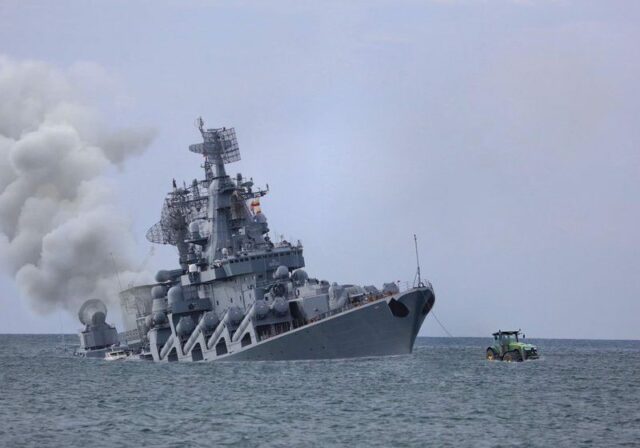
Russia’s New Maritime Doctrine: Desperately Needed and Long Overdue
Publication: Eurasia Daily Monitor Volume: 19 Issue: 144
By:

On July 31, Russian President Vladimir Putin approved a new maritime doctrine, replacing the country’s previous Maritime Doctrine of the Russian Federation, instituted in June 2015 (Kremlin.ru, July 31).
The highly ambitious new 106-section policy states throughout that the main security threats to Russia are the ongoing US policy of global domination in the “World Ocean” and the North Atlantic Treaty Organization’s (NATO) continuing expansion of its membership and activities ever closer to Moscow’s borders. Beyond purely naval matters, the document’s extensive sections include discourse on maritime territorial issues, a broad shipbuilding program in the country’s commercial and naval sectors, Russia’s merchant marine and fishing fleets, scientific oceanographic research, subsea pipelines, digital infrastructure, improved navigational aids, space-based systems, port renovation and the construction of new harbors and shipbuilding facilities. The new maritime doctrine states that the Russian navy’s highest shipbuilding priority is constructing modern aircraft carriers (Fontanka.ru, July 31).
Prepared by the Russian Ministry of Defense, the new edition of the maritime doctrine differs from previous editions by being the first to clearly delineate national interests, risks, challenges and threats to national security from a maritime perspective, ranked by the degree of danger they represent (Morvesti.ru, September 12).
The new policy, however, offers no definitive solution to the country’s eternal naval strategic impasse, which dates back to the Russian navy’s founding in 1696 by Tsar Peter I—namely, how to overcome the strategic constraints imposed by the geographic isolation of the Baltic, Arctic, Black Sea, Pacific and Caspian fleets from one another. This isolation precludes concentrating Russian naval forces against perceived threats, which consequently can bring their numerical superiority into a conflict, as an Anglo-French combined squadron did during the Crimean War and the Japanese did at Tsushima, overwhelming Russian naval deployments.
These geographical constraints survived the Russian Empire into the Soviet period, which, after World War II, saw Russian regions in the Arctic become potential zones of conflict where the West deployed nuclear weapons aboard naval platforms, including from aircraft carriers and later from ballistic-missile submarines. This problem remains constant for the Russian navy to this day.
The doctrine’s intrinsic essence remains the same as earlier iterations of Russian naval policy—that is, the protection of Russia’s maritime interests, not only in Russian territorial waters but also worldwide. This in turn requires the Russian navy to facilitate as much as possible its various fleets’ tactical and strategic autonomy to cope with foreign threats. The new strategy asserts that the main threat to Russia’s maritime national security is “the desire of a number of states, primarily the United States and its allies, to dominate the World Ocean, including in the Arctic, as well as to achieve an overwhelming superiority of their naval forces” (Pravo.gov.ru, July 31). The new maritime doctrine accordingly asserts that Russian national interests extend to the entire World Ocean.
The day that the new Maritime Doctrine was promulgated, Russian President Vladimir Putin visited St. Petersburg to review the Main Naval Parade in honor of Navy Day. Putin touched on the new policy in his speech, telling the audience, “A new Naval Doctrine of Russia has been approved. We have openly outlined the borders and zones of Russia’s strategic national interests, both economic and vital. First of all, these are our Arctic waters” (TASS, July 31).
The emphasis on Russia’s northern seas is understandable, given that the other four nations that share Arctic territorial waters with Russia—the United States, Canada, Denmark and Norway—are all members of NATO. Even so, it opens up a vast new region to safeguard, as the previous primary mission of the Russian navy’s Northern Fleet was the protection and projection of Russia’s submarine-launched ballistic missile (SLBM) assets. In addition, Moscow’s increased interest in the polar regions has been the result of global warming opening this previously inaccessible region, thus giving Russia a west-east, Atlantic-Pacific maritime route through its Arctic territorial waters, the so-called “Northern Sea Route.”
Highlighting the need for a new naval policy has been the Russian navy’s lackluster performance in Putin’s “special military operation” against Ukraine, where Black Sea Fleet and Caspian Flotilla vessels initially delivered some of the Russian military’s first strikes on Ukrainian infrastructure.
Yet, it is one thing to proclaim a new naval doctrine and quite another to pay for and implement it. Interestingly, the new policy is silent about how the ambitious programs will be funded. For those with a sense of irony, the fact that Putin chose Russia’s Navy Day to announce the new policy was overshadowed by the fact that, simultaneously, a Ukrainian drone struck Russia’s Black Sea Sevastopol headquarters, leading to a cancellation of the festivities there (Komsomolskaya Pravda, July 31).
The incident provided a dismal coda to the Russian navy’s lackluster performance in Putin’s aggressive assault on Ukraine. Ultimately, the Black Sea Fleet’s low point occurred on April 13, when its flagship Slava-class guided-missile cruiser, the Moskva, was struck by two Ukrainian anti-ship missiles, sinking the craft early the next morning (Kommersant, July 31).
In a bitter blow to Russian naval pride, Ukraine subsequently declared the Moskva an underwater “cultural heritage site” (Focus.ua, April 20). The Russian government undoubtedly hopes that its new maritime doctrine will forestall similar cultural donations in the future.



